Individual Written Report 1: Nevada Ltd Expansion in Brazil
VerifiedAdded on 2020/04/21
|15
|3736
|85
Report
AI Summary
This individual written report examines the expansion strategy of Nevada Ltd, a French chocolate company, into the Brazilian market. The report analyzes three market entry options: agency, distributor, and joint venture, considering their advantages and disadvantages. The report recommends forming a joint venture with XYZ Incorporated to access the Brazilian chocolate market and establish a long-term presence. The report details the terms to be included in the joint venture agreement, highlighting the importance of careful drafting. The report provides a comprehensive analysis of the strategic considerations involved in international business expansion, including the assessment of local market knowledge, business practices, and the potential risks and rewards of each entry mode. The report emphasizes the benefits of a joint venture, such as resource pooling and risk sharing, and provides a framework for structuring a successful international partnership.
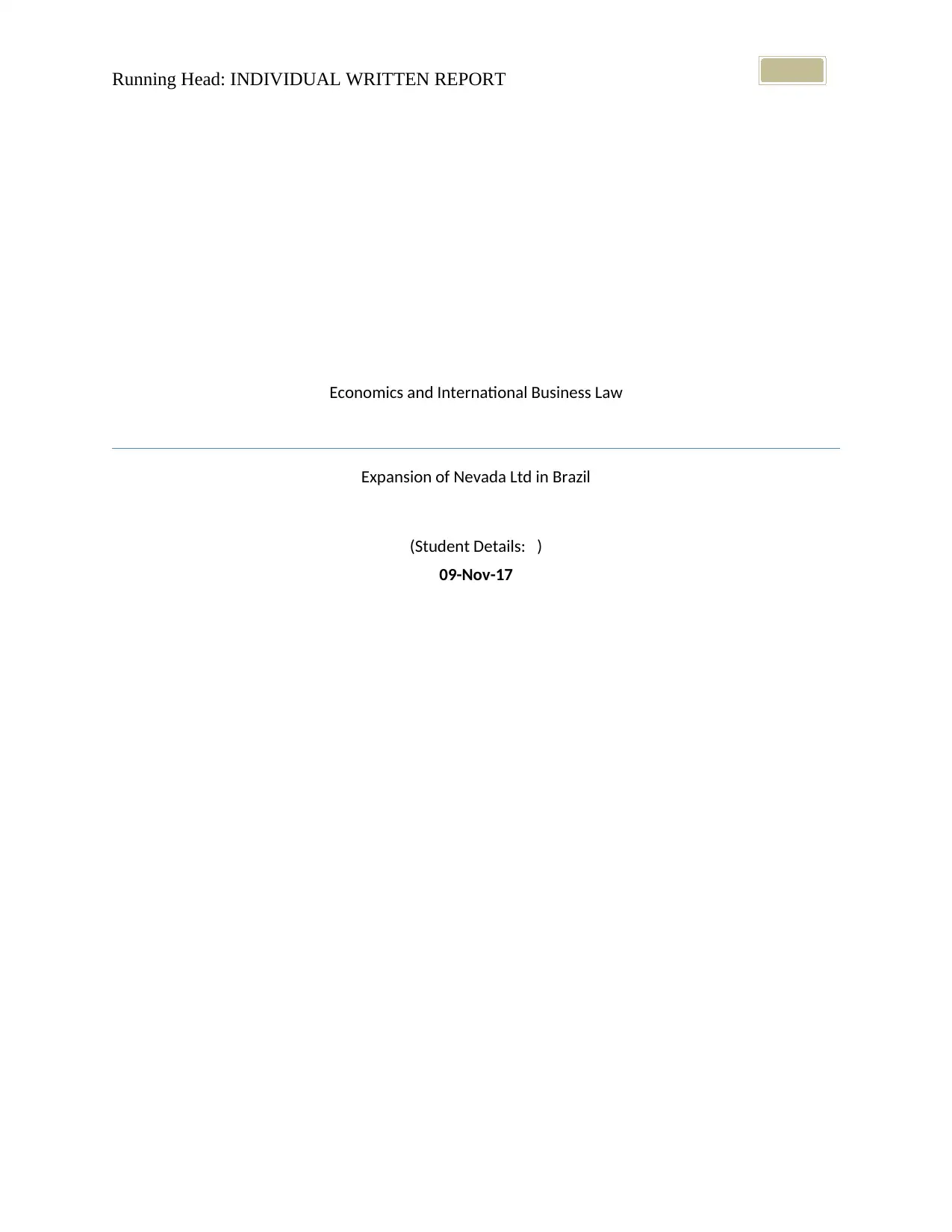
Running Head: INDIVIDUAL WRITTEN REPORT
Economics and International Business Law
Expansion of Nevada Ltd in Brazil
(Student Details: )
09-Nov-17
Economics and International Business Law
Expansion of Nevada Ltd in Brazil
(Student Details: )
09-Nov-17
Paraphrase This Document
Need a fresh take? Get an instant paraphrase of this document with our AI Paraphraser
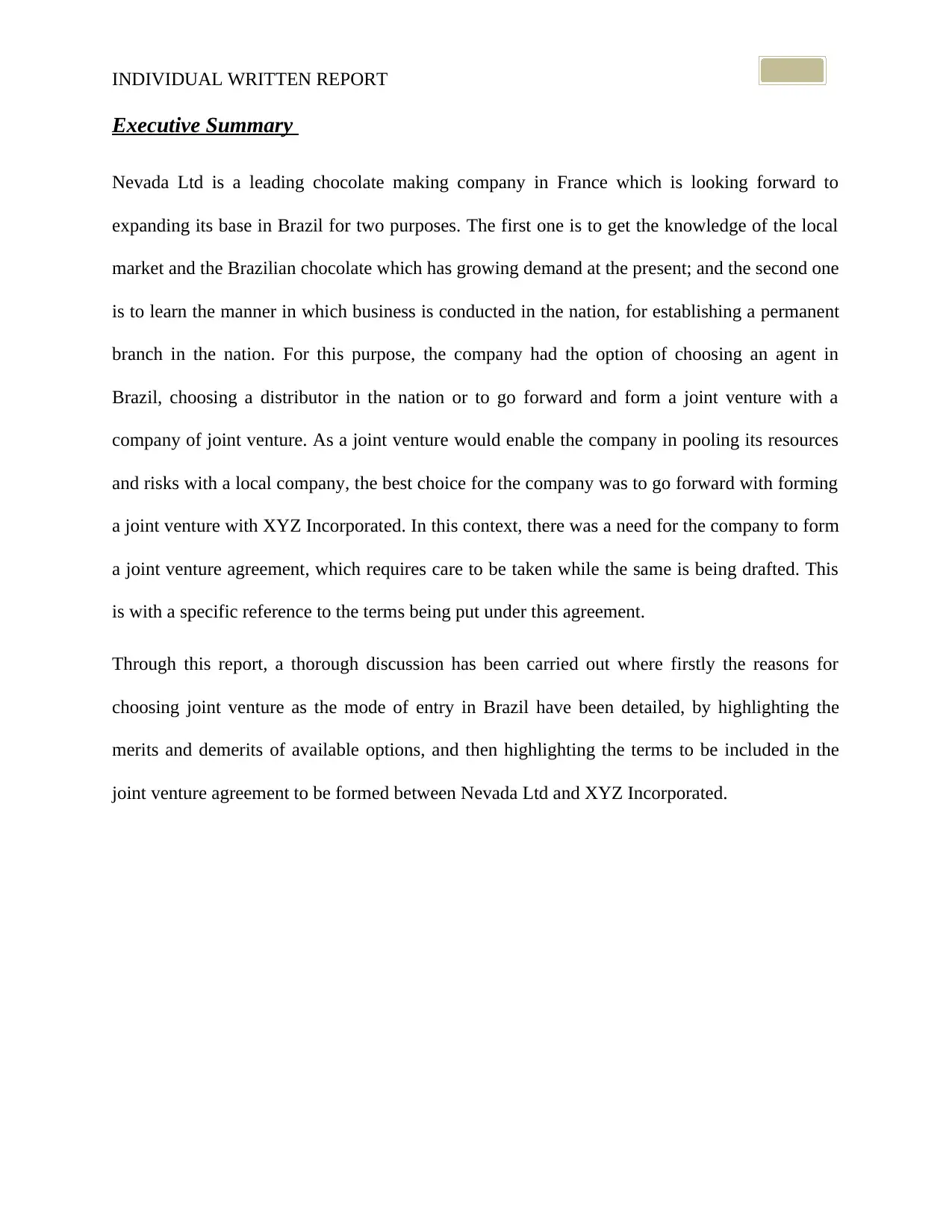
INDIVIDUAL WRITTEN REPORT
Executive Summary
Nevada Ltd is a leading chocolate making company in France which is looking forward to
expanding its base in Brazil for two purposes. The first one is to get the knowledge of the local
market and the Brazilian chocolate which has growing demand at the present; and the second one
is to learn the manner in which business is conducted in the nation, for establishing a permanent
branch in the nation. For this purpose, the company had the option of choosing an agent in
Brazil, choosing a distributor in the nation or to go forward and form a joint venture with a
company of joint venture. As a joint venture would enable the company in pooling its resources
and risks with a local company, the best choice for the company was to go forward with forming
a joint venture with XYZ Incorporated. In this context, there was a need for the company to form
a joint venture agreement, which requires care to be taken while the same is being drafted. This
is with a specific reference to the terms being put under this agreement.
Through this report, a thorough discussion has been carried out where firstly the reasons for
choosing joint venture as the mode of entry in Brazil have been detailed, by highlighting the
merits and demerits of available options, and then highlighting the terms to be included in the
joint venture agreement to be formed between Nevada Ltd and XYZ Incorporated.
Executive Summary
Nevada Ltd is a leading chocolate making company in France which is looking forward to
expanding its base in Brazil for two purposes. The first one is to get the knowledge of the local
market and the Brazilian chocolate which has growing demand at the present; and the second one
is to learn the manner in which business is conducted in the nation, for establishing a permanent
branch in the nation. For this purpose, the company had the option of choosing an agent in
Brazil, choosing a distributor in the nation or to go forward and form a joint venture with a
company of joint venture. As a joint venture would enable the company in pooling its resources
and risks with a local company, the best choice for the company was to go forward with forming
a joint venture with XYZ Incorporated. In this context, there was a need for the company to form
a joint venture agreement, which requires care to be taken while the same is being drafted. This
is with a specific reference to the terms being put under this agreement.
Through this report, a thorough discussion has been carried out where firstly the reasons for
choosing joint venture as the mode of entry in Brazil have been detailed, by highlighting the
merits and demerits of available options, and then highlighting the terms to be included in the
joint venture agreement to be formed between Nevada Ltd and XYZ Incorporated.
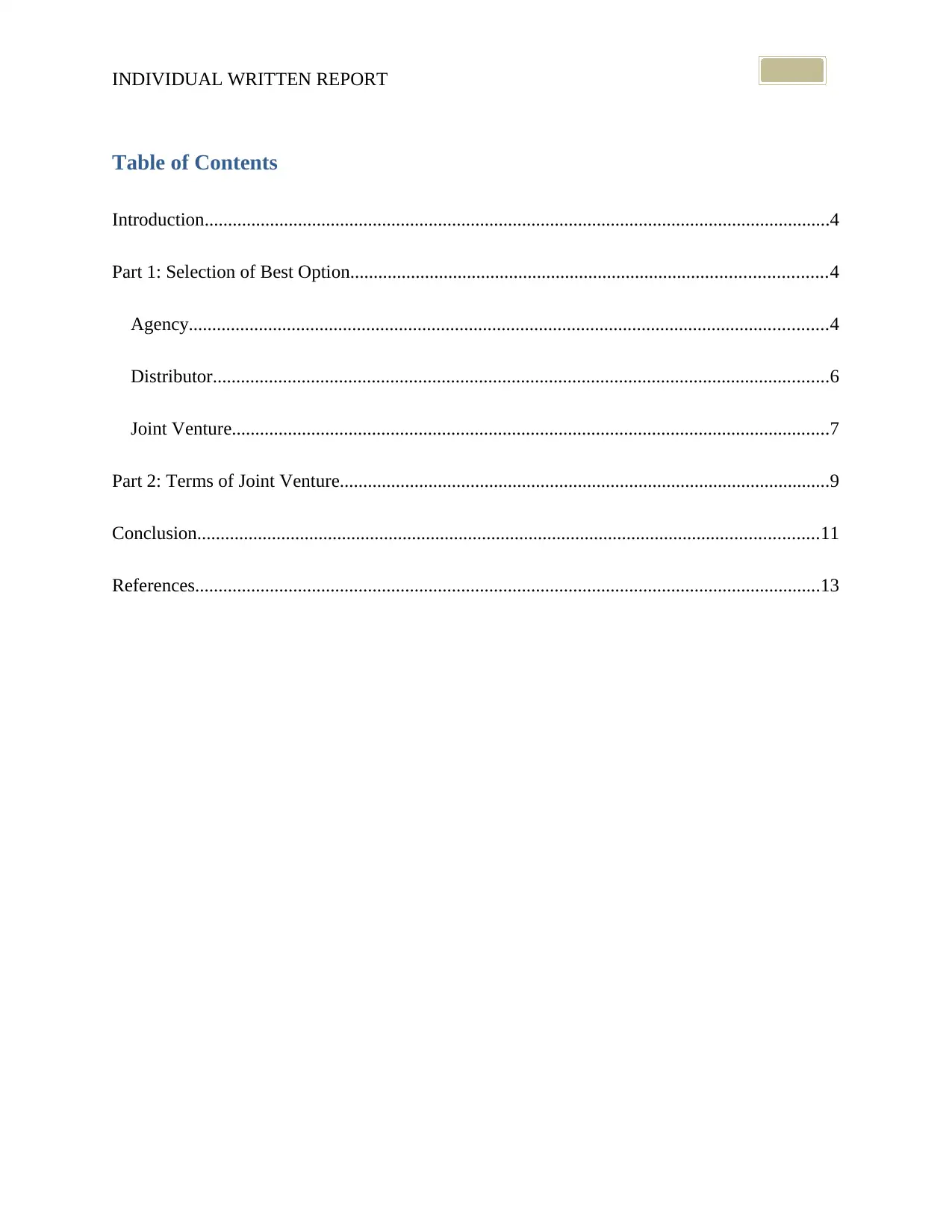
INDIVIDUAL WRITTEN REPORT
Table of Contents
Introduction......................................................................................................................................4
Part 1: Selection of Best Option......................................................................................................4
Agency.........................................................................................................................................4
Distributor....................................................................................................................................6
Joint Venture................................................................................................................................7
Part 2: Terms of Joint Venture.........................................................................................................9
Conclusion.....................................................................................................................................11
References......................................................................................................................................13
Table of Contents
Introduction......................................................................................................................................4
Part 1: Selection of Best Option......................................................................................................4
Agency.........................................................................................................................................4
Distributor....................................................................................................................................6
Joint Venture................................................................................................................................7
Part 2: Terms of Joint Venture.........................................................................................................9
Conclusion.....................................................................................................................................11
References......................................................................................................................................13
⊘ This is a preview!⊘
Do you want full access?
Subscribe today to unlock all pages.

Trusted by 1+ million students worldwide
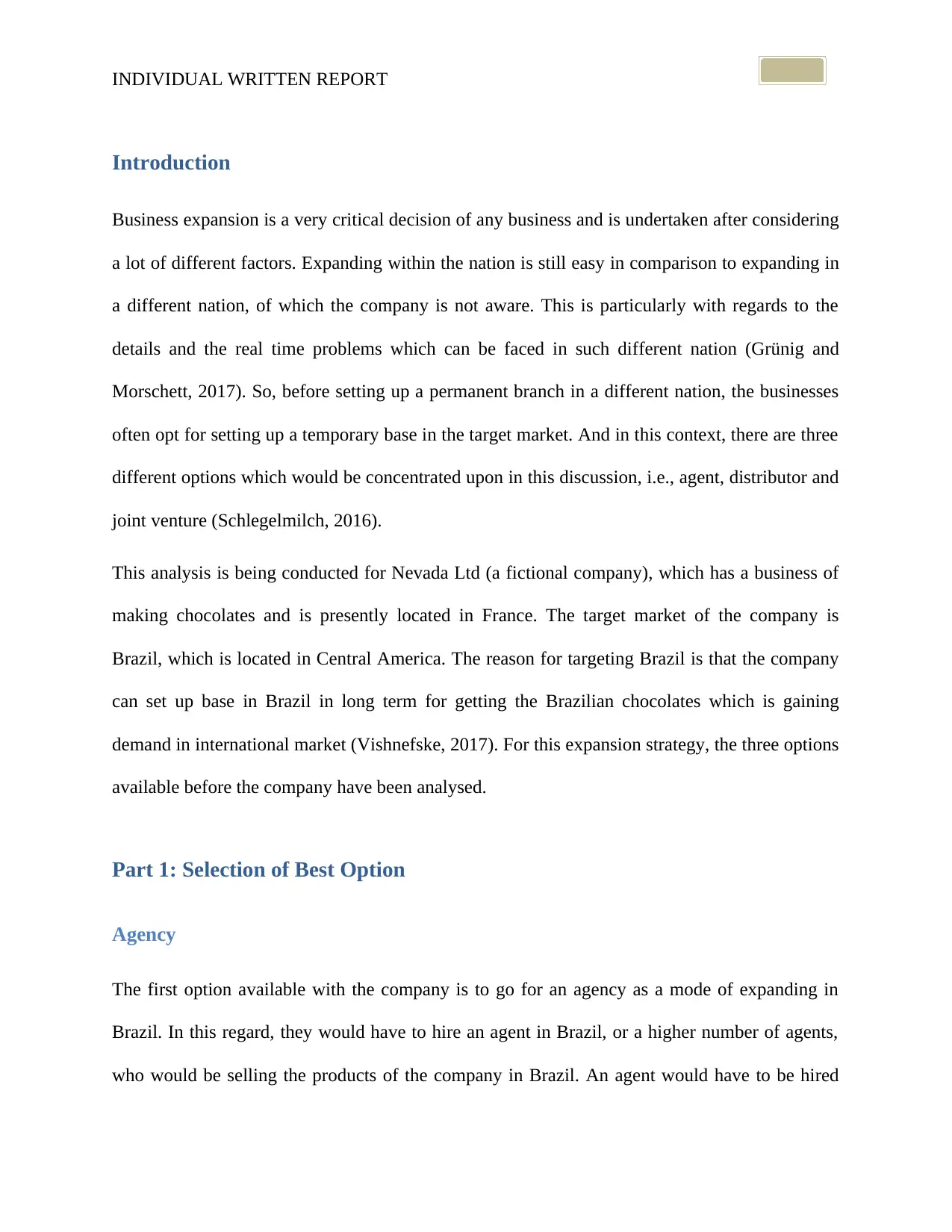
INDIVIDUAL WRITTEN REPORT
Introduction
Business expansion is a very critical decision of any business and is undertaken after considering
a lot of different factors. Expanding within the nation is still easy in comparison to expanding in
a different nation, of which the company is not aware. This is particularly with regards to the
details and the real time problems which can be faced in such different nation (Grünig and
Morschett, 2017). So, before setting up a permanent branch in a different nation, the businesses
often opt for setting up a temporary base in the target market. And in this context, there are three
different options which would be concentrated upon in this discussion, i.e., agent, distributor and
joint venture (Schlegelmilch, 2016).
This analysis is being conducted for Nevada Ltd (a fictional company), which has a business of
making chocolates and is presently located in France. The target market of the company is
Brazil, which is located in Central America. The reason for targeting Brazil is that the company
can set up base in Brazil in long term for getting the Brazilian chocolates which is gaining
demand in international market (Vishnefske, 2017). For this expansion strategy, the three options
available before the company have been analysed.
Part 1: Selection of Best Option
Agency
The first option available with the company is to go for an agency as a mode of expanding in
Brazil. In this regard, they would have to hire an agent in Brazil, or a higher number of agents,
who would be selling the products of the company in Brazil. An agent would have to be hired
Introduction
Business expansion is a very critical decision of any business and is undertaken after considering
a lot of different factors. Expanding within the nation is still easy in comparison to expanding in
a different nation, of which the company is not aware. This is particularly with regards to the
details and the real time problems which can be faced in such different nation (Grünig and
Morschett, 2017). So, before setting up a permanent branch in a different nation, the businesses
often opt for setting up a temporary base in the target market. And in this context, there are three
different options which would be concentrated upon in this discussion, i.e., agent, distributor and
joint venture (Schlegelmilch, 2016).
This analysis is being conducted for Nevada Ltd (a fictional company), which has a business of
making chocolates and is presently located in France. The target market of the company is
Brazil, which is located in Central America. The reason for targeting Brazil is that the company
can set up base in Brazil in long term for getting the Brazilian chocolates which is gaining
demand in international market (Vishnefske, 2017). For this expansion strategy, the three options
available before the company have been analysed.
Part 1: Selection of Best Option
Agency
The first option available with the company is to go for an agency as a mode of expanding in
Brazil. In this regard, they would have to hire an agent in Brazil, or a higher number of agents,
who would be selling the products of the company in Brazil. An agent would have to be hired
Paraphrase This Document
Need a fresh take? Get an instant paraphrase of this document with our AI Paraphraser
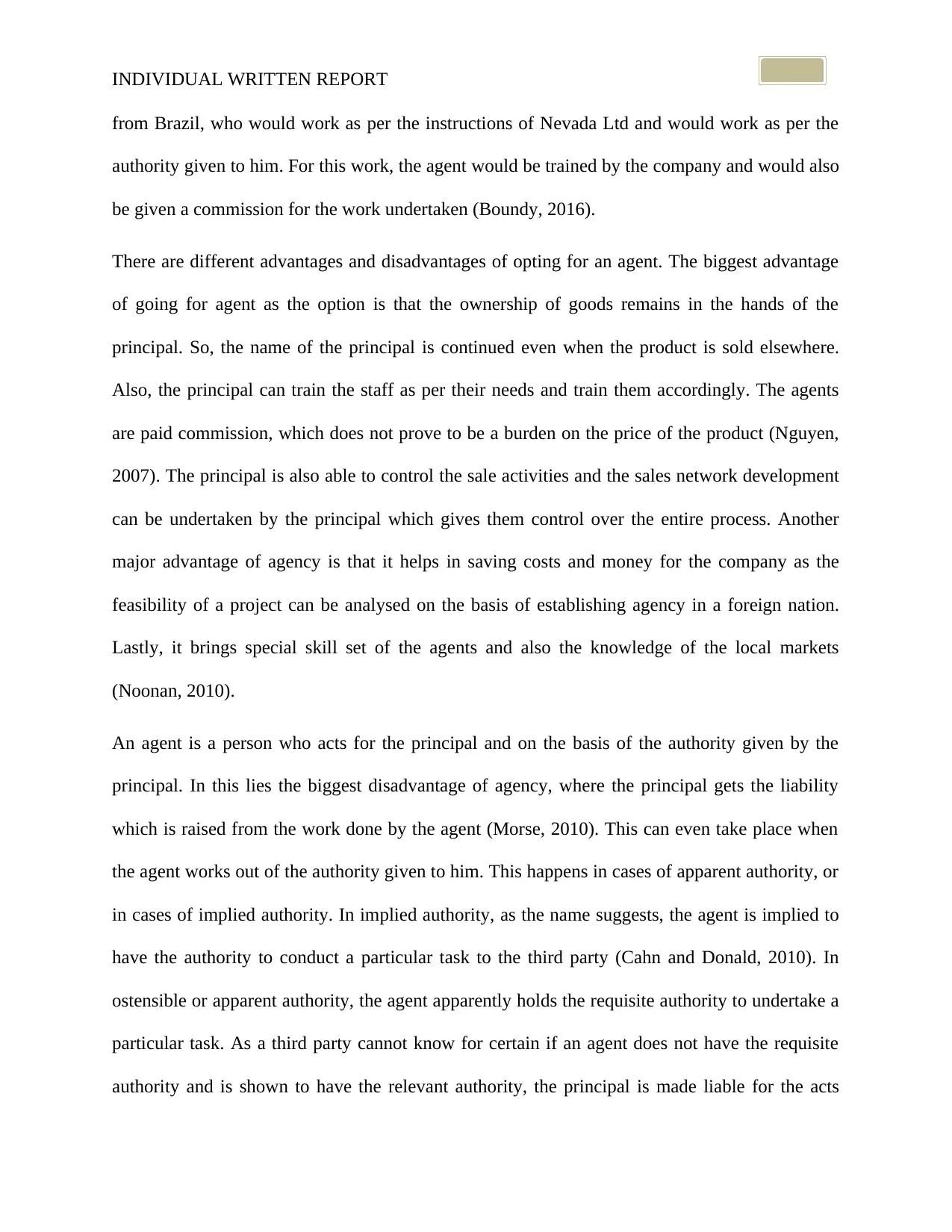
INDIVIDUAL WRITTEN REPORT
from Brazil, who would work as per the instructions of Nevada Ltd and would work as per the
authority given to him. For this work, the agent would be trained by the company and would also
be given a commission for the work undertaken (Boundy, 2016).
There are different advantages and disadvantages of opting for an agent. The biggest advantage
of going for agent as the option is that the ownership of goods remains in the hands of the
principal. So, the name of the principal is continued even when the product is sold elsewhere.
Also, the principal can train the staff as per their needs and train them accordingly. The agents
are paid commission, which does not prove to be a burden on the price of the product (Nguyen,
2007). The principal is also able to control the sale activities and the sales network development
can be undertaken by the principal which gives them control over the entire process. Another
major advantage of agency is that it helps in saving costs and money for the company as the
feasibility of a project can be analysed on the basis of establishing agency in a foreign nation.
Lastly, it brings special skill set of the agents and also the knowledge of the local markets
(Noonan, 2010).
An agent is a person who acts for the principal and on the basis of the authority given by the
principal. In this lies the biggest disadvantage of agency, where the principal gets the liability
which is raised from the work done by the agent (Morse, 2010). This can even take place when
the agent works out of the authority given to him. This happens in cases of apparent authority, or
in cases of implied authority. In implied authority, as the name suggests, the agent is implied to
have the authority to conduct a particular task to the third party (Cahn and Donald, 2010). In
ostensible or apparent authority, the agent apparently holds the requisite authority to undertake a
particular task. As a third party cannot know for certain if an agent does not have the requisite
authority and is shown to have the relevant authority, the principal is made liable for the acts
from Brazil, who would work as per the instructions of Nevada Ltd and would work as per the
authority given to him. For this work, the agent would be trained by the company and would also
be given a commission for the work undertaken (Boundy, 2016).
There are different advantages and disadvantages of opting for an agent. The biggest advantage
of going for agent as the option is that the ownership of goods remains in the hands of the
principal. So, the name of the principal is continued even when the product is sold elsewhere.
Also, the principal can train the staff as per their needs and train them accordingly. The agents
are paid commission, which does not prove to be a burden on the price of the product (Nguyen,
2007). The principal is also able to control the sale activities and the sales network development
can be undertaken by the principal which gives them control over the entire process. Another
major advantage of agency is that it helps in saving costs and money for the company as the
feasibility of a project can be analysed on the basis of establishing agency in a foreign nation.
Lastly, it brings special skill set of the agents and also the knowledge of the local markets
(Noonan, 2010).
An agent is a person who acts for the principal and on the basis of the authority given by the
principal. In this lies the biggest disadvantage of agency, where the principal gets the liability
which is raised from the work done by the agent (Morse, 2010). This can even take place when
the agent works out of the authority given to him. This happens in cases of apparent authority, or
in cases of implied authority. In implied authority, as the name suggests, the agent is implied to
have the authority to conduct a particular task to the third party (Cahn and Donald, 2010). In
ostensible or apparent authority, the agent apparently holds the requisite authority to undertake a
particular task. As a third party cannot know for certain if an agent does not have the requisite
authority and is shown to have the relevant authority, the principal is made liable for the acts
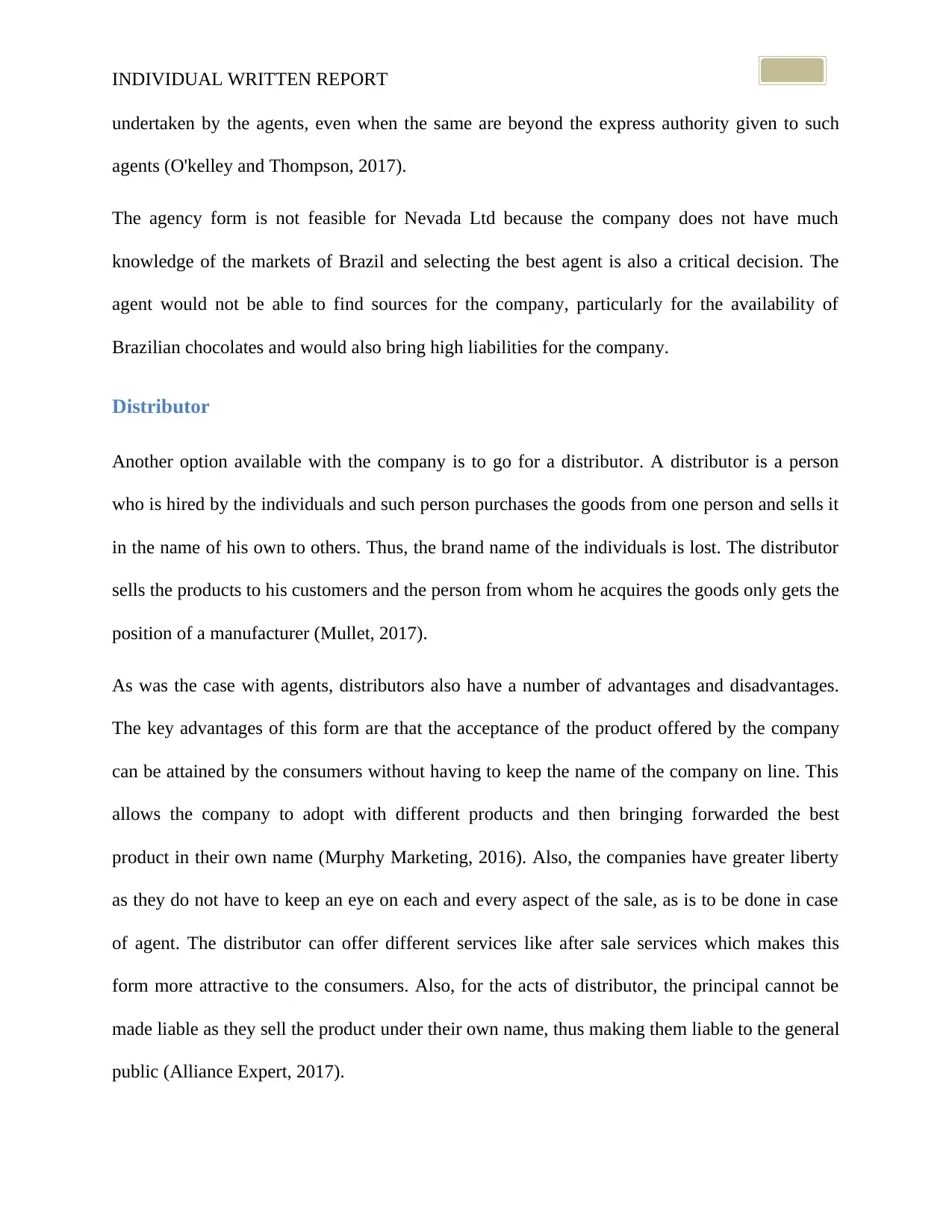
INDIVIDUAL WRITTEN REPORT
undertaken by the agents, even when the same are beyond the express authority given to such
agents (O'kelley and Thompson, 2017).
The agency form is not feasible for Nevada Ltd because the company does not have much
knowledge of the markets of Brazil and selecting the best agent is also a critical decision. The
agent would not be able to find sources for the company, particularly for the availability of
Brazilian chocolates and would also bring high liabilities for the company.
Distributor
Another option available with the company is to go for a distributor. A distributor is a person
who is hired by the individuals and such person purchases the goods from one person and sells it
in the name of his own to others. Thus, the brand name of the individuals is lost. The distributor
sells the products to his customers and the person from whom he acquires the goods only gets the
position of a manufacturer (Mullet, 2017).
As was the case with agents, distributors also have a number of advantages and disadvantages.
The key advantages of this form are that the acceptance of the product offered by the company
can be attained by the consumers without having to keep the name of the company on line. This
allows the company to adopt with different products and then bringing forwarded the best
product in their own name (Murphy Marketing, 2016). Also, the companies have greater liberty
as they do not have to keep an eye on each and every aspect of the sale, as is to be done in case
of agent. The distributor can offer different services like after sale services which makes this
form more attractive to the consumers. Also, for the acts of distributor, the principal cannot be
made liable as they sell the product under their own name, thus making them liable to the general
public (Alliance Expert, 2017).
undertaken by the agents, even when the same are beyond the express authority given to such
agents (O'kelley and Thompson, 2017).
The agency form is not feasible for Nevada Ltd because the company does not have much
knowledge of the markets of Brazil and selecting the best agent is also a critical decision. The
agent would not be able to find sources for the company, particularly for the availability of
Brazilian chocolates and would also bring high liabilities for the company.
Distributor
Another option available with the company is to go for a distributor. A distributor is a person
who is hired by the individuals and such person purchases the goods from one person and sells it
in the name of his own to others. Thus, the brand name of the individuals is lost. The distributor
sells the products to his customers and the person from whom he acquires the goods only gets the
position of a manufacturer (Mullet, 2017).
As was the case with agents, distributors also have a number of advantages and disadvantages.
The key advantages of this form are that the acceptance of the product offered by the company
can be attained by the consumers without having to keep the name of the company on line. This
allows the company to adopt with different products and then bringing forwarded the best
product in their own name (Murphy Marketing, 2016). Also, the companies have greater liberty
as they do not have to keep an eye on each and every aspect of the sale, as is to be done in case
of agent. The distributor can offer different services like after sale services which makes this
form more attractive to the consumers. Also, for the acts of distributor, the principal cannot be
made liable as they sell the product under their own name, thus making them liable to the general
public (Alliance Expert, 2017).
⊘ This is a preview!⊘
Do you want full access?
Subscribe today to unlock all pages.

Trusted by 1+ million students worldwide
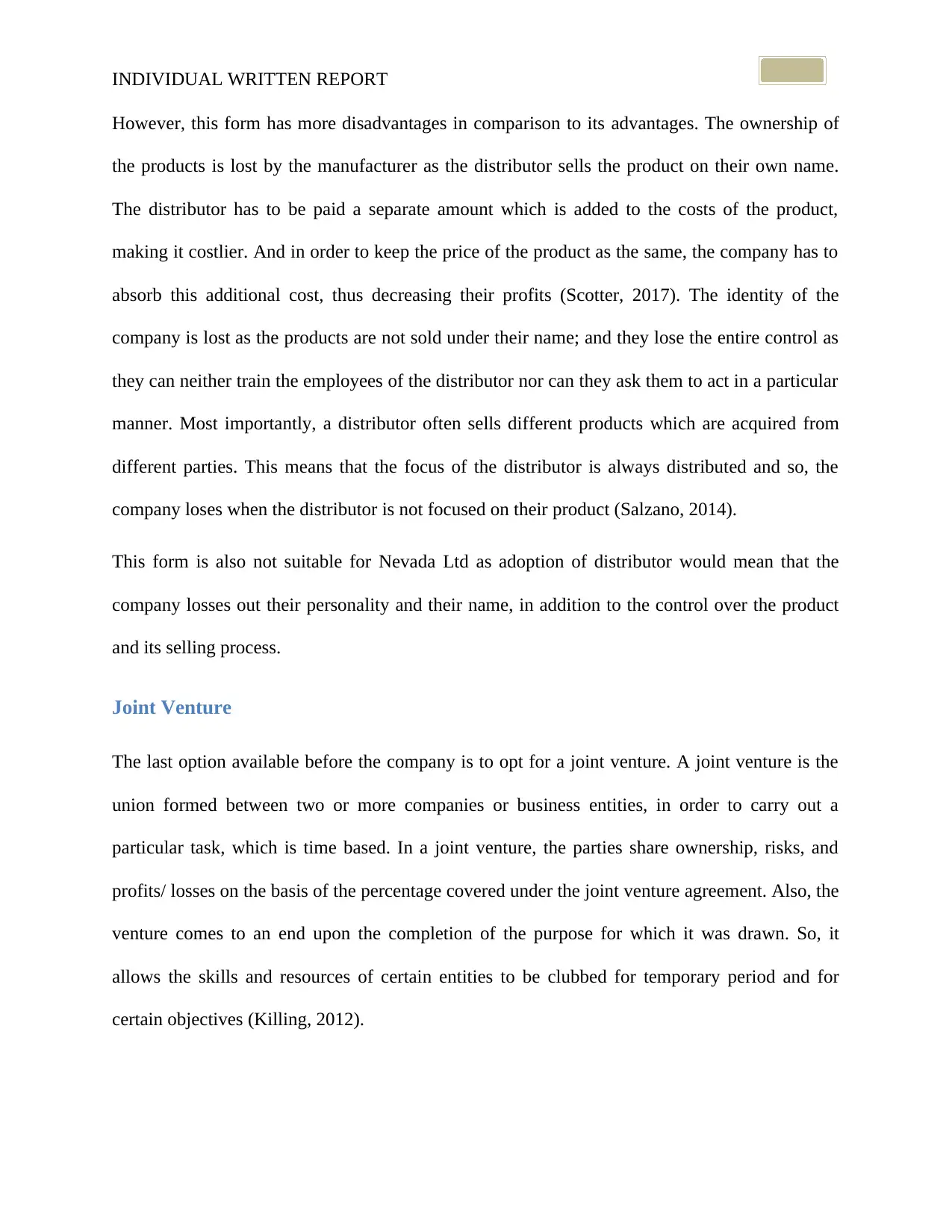
INDIVIDUAL WRITTEN REPORT
However, this form has more disadvantages in comparison to its advantages. The ownership of
the products is lost by the manufacturer as the distributor sells the product on their own name.
The distributor has to be paid a separate amount which is added to the costs of the product,
making it costlier. And in order to keep the price of the product as the same, the company has to
absorb this additional cost, thus decreasing their profits (Scotter, 2017). The identity of the
company is lost as the products are not sold under their name; and they lose the entire control as
they can neither train the employees of the distributor nor can they ask them to act in a particular
manner. Most importantly, a distributor often sells different products which are acquired from
different parties. This means that the focus of the distributor is always distributed and so, the
company loses when the distributor is not focused on their product (Salzano, 2014).
This form is also not suitable for Nevada Ltd as adoption of distributor would mean that the
company losses out their personality and their name, in addition to the control over the product
and its selling process.
Joint Venture
The last option available before the company is to opt for a joint venture. A joint venture is the
union formed between two or more companies or business entities, in order to carry out a
particular task, which is time based. In a joint venture, the parties share ownership, risks, and
profits/ losses on the basis of the percentage covered under the joint venture agreement. Also, the
venture comes to an end upon the completion of the purpose for which it was drawn. So, it
allows the skills and resources of certain entities to be clubbed for temporary period and for
certain objectives (Killing, 2012).
However, this form has more disadvantages in comparison to its advantages. The ownership of
the products is lost by the manufacturer as the distributor sells the product on their own name.
The distributor has to be paid a separate amount which is added to the costs of the product,
making it costlier. And in order to keep the price of the product as the same, the company has to
absorb this additional cost, thus decreasing their profits (Scotter, 2017). The identity of the
company is lost as the products are not sold under their name; and they lose the entire control as
they can neither train the employees of the distributor nor can they ask them to act in a particular
manner. Most importantly, a distributor often sells different products which are acquired from
different parties. This means that the focus of the distributor is always distributed and so, the
company loses when the distributor is not focused on their product (Salzano, 2014).
This form is also not suitable for Nevada Ltd as adoption of distributor would mean that the
company losses out their personality and their name, in addition to the control over the product
and its selling process.
Joint Venture
The last option available before the company is to opt for a joint venture. A joint venture is the
union formed between two or more companies or business entities, in order to carry out a
particular task, which is time based. In a joint venture, the parties share ownership, risks, and
profits/ losses on the basis of the percentage covered under the joint venture agreement. Also, the
venture comes to an end upon the completion of the purpose for which it was drawn. So, it
allows the skills and resources of certain entities to be clubbed for temporary period and for
certain objectives (Killing, 2012).
Paraphrase This Document
Need a fresh take? Get an instant paraphrase of this document with our AI Paraphraser
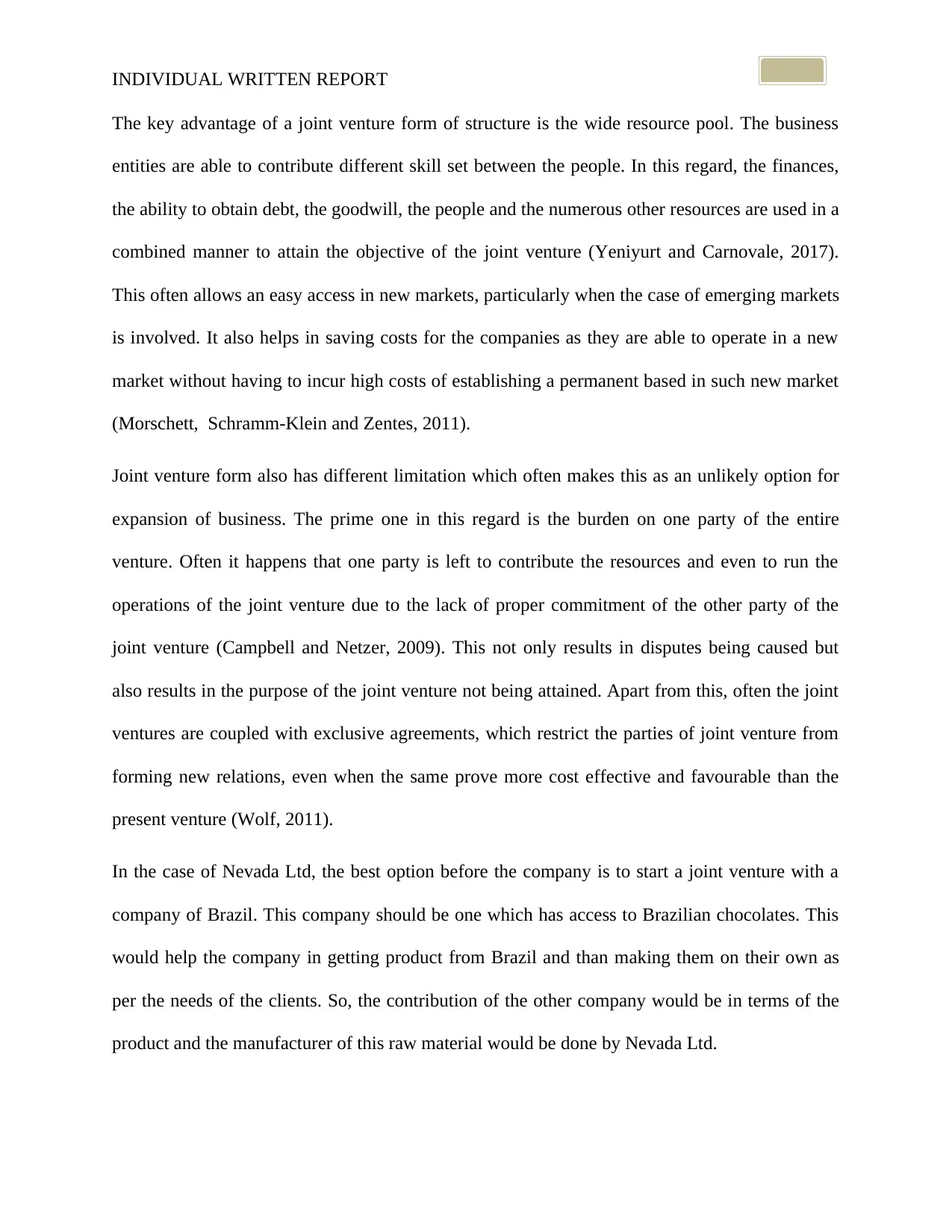
INDIVIDUAL WRITTEN REPORT
The key advantage of a joint venture form of structure is the wide resource pool. The business
entities are able to contribute different skill set between the people. In this regard, the finances,
the ability to obtain debt, the goodwill, the people and the numerous other resources are used in a
combined manner to attain the objective of the joint venture (Yeniyurt and Carnovale, 2017).
This often allows an easy access in new markets, particularly when the case of emerging markets
is involved. It also helps in saving costs for the companies as they are able to operate in a new
market without having to incur high costs of establishing a permanent based in such new market
(Morschett, Schramm-Klein and Zentes, 2011).
Joint venture form also has different limitation which often makes this as an unlikely option for
expansion of business. The prime one in this regard is the burden on one party of the entire
venture. Often it happens that one party is left to contribute the resources and even to run the
operations of the joint venture due to the lack of proper commitment of the other party of the
joint venture (Campbell and Netzer, 2009). This not only results in disputes being caused but
also results in the purpose of the joint venture not being attained. Apart from this, often the joint
ventures are coupled with exclusive agreements, which restrict the parties of joint venture from
forming new relations, even when the same prove more cost effective and favourable than the
present venture (Wolf, 2011).
In the case of Nevada Ltd, the best option before the company is to start a joint venture with a
company of Brazil. This company should be one which has access to Brazilian chocolates. This
would help the company in getting product from Brazil and than making them on their own as
per the needs of the clients. So, the contribution of the other company would be in terms of the
product and the manufacturer of this raw material would be done by Nevada Ltd.
The key advantage of a joint venture form of structure is the wide resource pool. The business
entities are able to contribute different skill set between the people. In this regard, the finances,
the ability to obtain debt, the goodwill, the people and the numerous other resources are used in a
combined manner to attain the objective of the joint venture (Yeniyurt and Carnovale, 2017).
This often allows an easy access in new markets, particularly when the case of emerging markets
is involved. It also helps in saving costs for the companies as they are able to operate in a new
market without having to incur high costs of establishing a permanent based in such new market
(Morschett, Schramm-Klein and Zentes, 2011).
Joint venture form also has different limitation which often makes this as an unlikely option for
expansion of business. The prime one in this regard is the burden on one party of the entire
venture. Often it happens that one party is left to contribute the resources and even to run the
operations of the joint venture due to the lack of proper commitment of the other party of the
joint venture (Campbell and Netzer, 2009). This not only results in disputes being caused but
also results in the purpose of the joint venture not being attained. Apart from this, often the joint
ventures are coupled with exclusive agreements, which restrict the parties of joint venture from
forming new relations, even when the same prove more cost effective and favourable than the
present venture (Wolf, 2011).
In the case of Nevada Ltd, the best option before the company is to start a joint venture with a
company of Brazil. This company should be one which has access to Brazilian chocolates. This
would help the company in getting product from Brazil and than making them on their own as
per the needs of the clients. So, the contribution of the other company would be in terms of the
product and the manufacturer of this raw material would be done by Nevada Ltd.
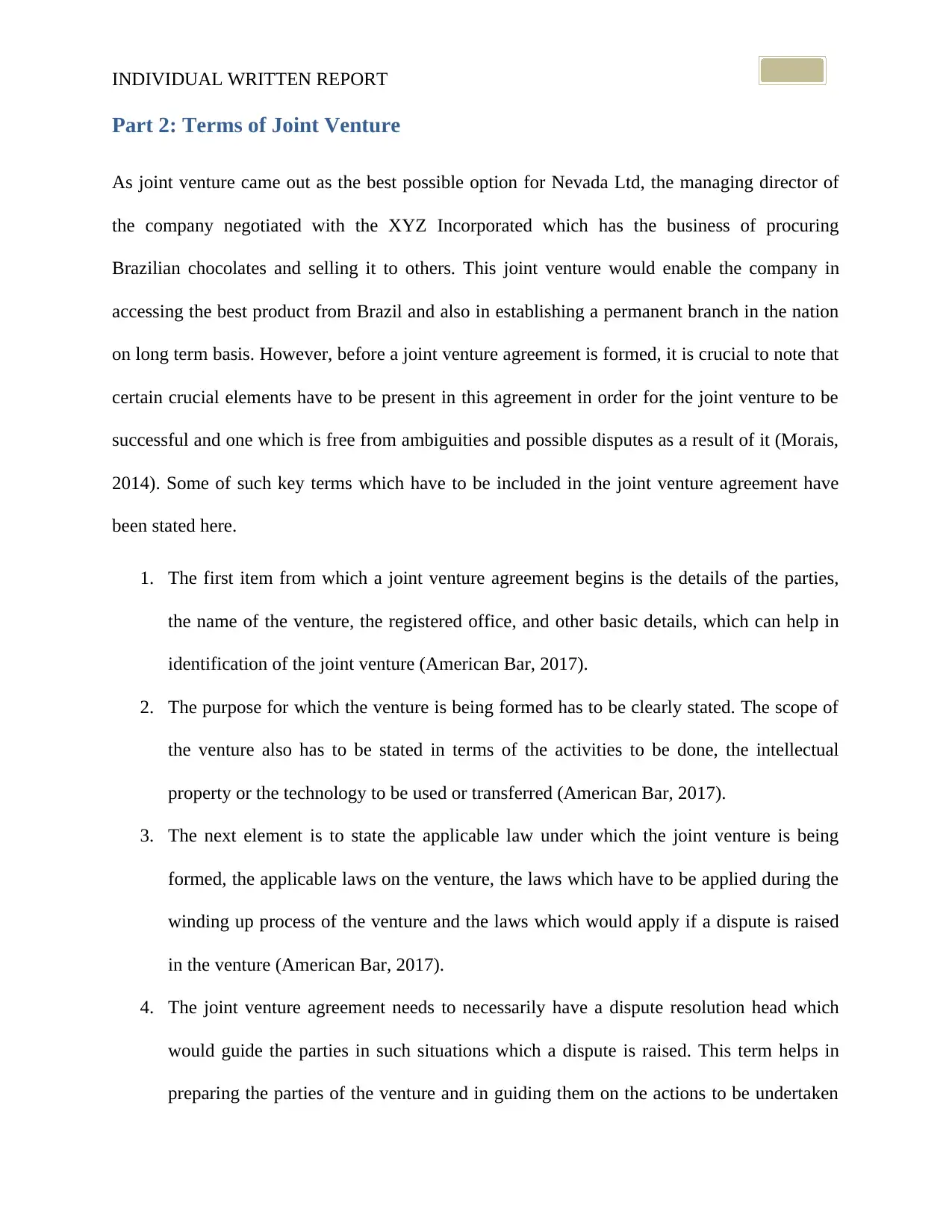
INDIVIDUAL WRITTEN REPORT
Part 2: Terms of Joint Venture
As joint venture came out as the best possible option for Nevada Ltd, the managing director of
the company negotiated with the XYZ Incorporated which has the business of procuring
Brazilian chocolates and selling it to others. This joint venture would enable the company in
accessing the best product from Brazil and also in establishing a permanent branch in the nation
on long term basis. However, before a joint venture agreement is formed, it is crucial to note that
certain crucial elements have to be present in this agreement in order for the joint venture to be
successful and one which is free from ambiguities and possible disputes as a result of it (Morais,
2014). Some of such key terms which have to be included in the joint venture agreement have
been stated here.
1. The first item from which a joint venture agreement begins is the details of the parties,
the name of the venture, the registered office, and other basic details, which can help in
identification of the joint venture (American Bar, 2017).
2. The purpose for which the venture is being formed has to be clearly stated. The scope of
the venture also has to be stated in terms of the activities to be done, the intellectual
property or the technology to be used or transferred (American Bar, 2017).
3. The next element is to state the applicable law under which the joint venture is being
formed, the applicable laws on the venture, the laws which have to be applied during the
winding up process of the venture and the laws which would apply if a dispute is raised
in the venture (American Bar, 2017).
4. The joint venture agreement needs to necessarily have a dispute resolution head which
would guide the parties in such situations which a dispute is raised. This term helps in
preparing the parties of the venture and in guiding them on the actions to be undertaken
Part 2: Terms of Joint Venture
As joint venture came out as the best possible option for Nevada Ltd, the managing director of
the company negotiated with the XYZ Incorporated which has the business of procuring
Brazilian chocolates and selling it to others. This joint venture would enable the company in
accessing the best product from Brazil and also in establishing a permanent branch in the nation
on long term basis. However, before a joint venture agreement is formed, it is crucial to note that
certain crucial elements have to be present in this agreement in order for the joint venture to be
successful and one which is free from ambiguities and possible disputes as a result of it (Morais,
2014). Some of such key terms which have to be included in the joint venture agreement have
been stated here.
1. The first item from which a joint venture agreement begins is the details of the parties,
the name of the venture, the registered office, and other basic details, which can help in
identification of the joint venture (American Bar, 2017).
2. The purpose for which the venture is being formed has to be clearly stated. The scope of
the venture also has to be stated in terms of the activities to be done, the intellectual
property or the technology to be used or transferred (American Bar, 2017).
3. The next element is to state the applicable law under which the joint venture is being
formed, the applicable laws on the venture, the laws which have to be applied during the
winding up process of the venture and the laws which would apply if a dispute is raised
in the venture (American Bar, 2017).
4. The joint venture agreement needs to necessarily have a dispute resolution head which
would guide the parties in such situations which a dispute is raised. This term helps in
preparing the parties of the venture and in guiding them on the actions to be undertaken
⊘ This is a preview!⊘
Do you want full access?
Subscribe today to unlock all pages.

Trusted by 1+ million students worldwide
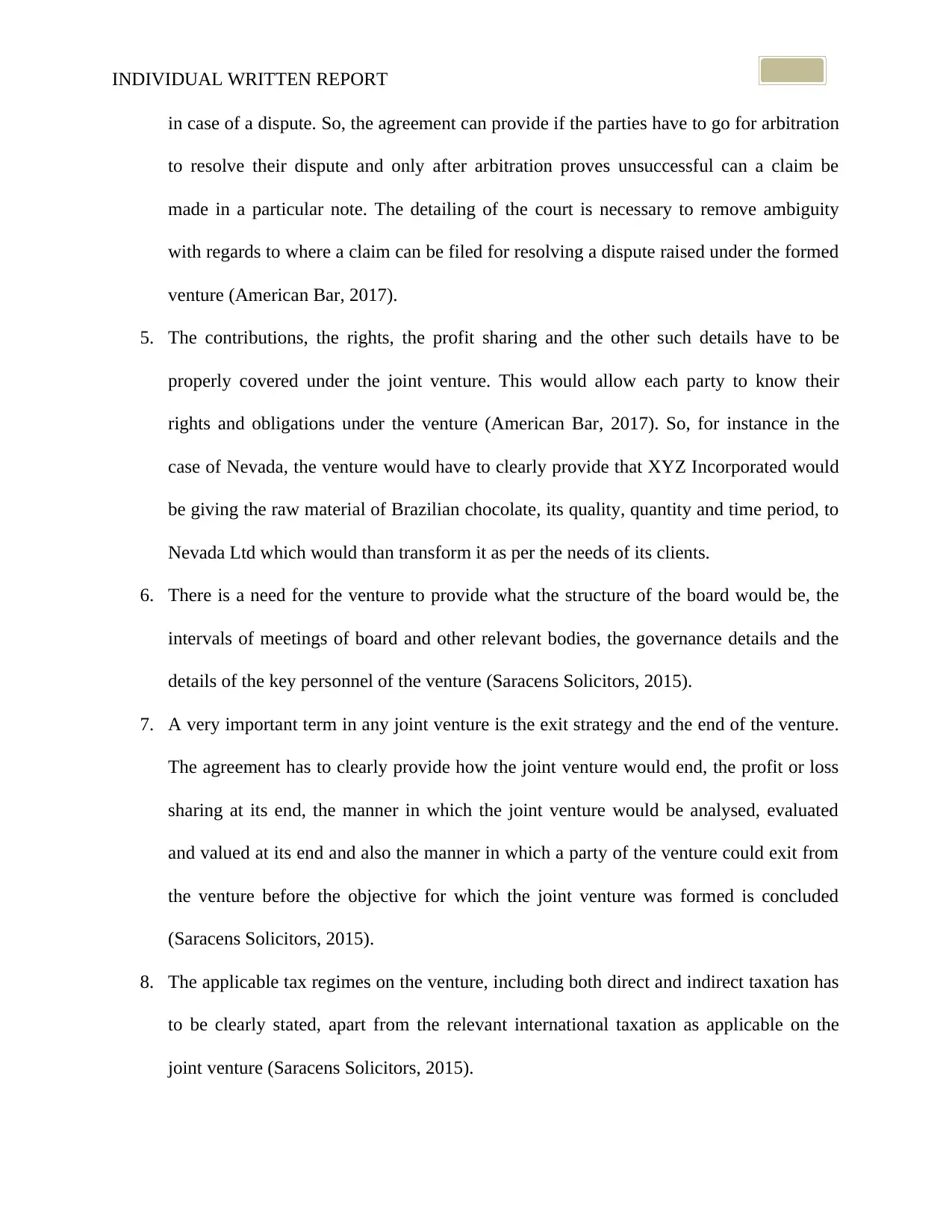
INDIVIDUAL WRITTEN REPORT
in case of a dispute. So, the agreement can provide if the parties have to go for arbitration
to resolve their dispute and only after arbitration proves unsuccessful can a claim be
made in a particular note. The detailing of the court is necessary to remove ambiguity
with regards to where a claim can be filed for resolving a dispute raised under the formed
venture (American Bar, 2017).
5. The contributions, the rights, the profit sharing and the other such details have to be
properly covered under the joint venture. This would allow each party to know their
rights and obligations under the venture (American Bar, 2017). So, for instance in the
case of Nevada, the venture would have to clearly provide that XYZ Incorporated would
be giving the raw material of Brazilian chocolate, its quality, quantity and time period, to
Nevada Ltd which would than transform it as per the needs of its clients.
6. There is a need for the venture to provide what the structure of the board would be, the
intervals of meetings of board and other relevant bodies, the governance details and the
details of the key personnel of the venture (Saracens Solicitors, 2015).
7. A very important term in any joint venture is the exit strategy and the end of the venture.
The agreement has to clearly provide how the joint venture would end, the profit or loss
sharing at its end, the manner in which the joint venture would be analysed, evaluated
and valued at its end and also the manner in which a party of the venture could exit from
the venture before the objective for which the joint venture was formed is concluded
(Saracens Solicitors, 2015).
8. The applicable tax regimes on the venture, including both direct and indirect taxation has
to be clearly stated, apart from the relevant international taxation as applicable on the
joint venture (Saracens Solicitors, 2015).
in case of a dispute. So, the agreement can provide if the parties have to go for arbitration
to resolve their dispute and only after arbitration proves unsuccessful can a claim be
made in a particular note. The detailing of the court is necessary to remove ambiguity
with regards to where a claim can be filed for resolving a dispute raised under the formed
venture (American Bar, 2017).
5. The contributions, the rights, the profit sharing and the other such details have to be
properly covered under the joint venture. This would allow each party to know their
rights and obligations under the venture (American Bar, 2017). So, for instance in the
case of Nevada, the venture would have to clearly provide that XYZ Incorporated would
be giving the raw material of Brazilian chocolate, its quality, quantity and time period, to
Nevada Ltd which would than transform it as per the needs of its clients.
6. There is a need for the venture to provide what the structure of the board would be, the
intervals of meetings of board and other relevant bodies, the governance details and the
details of the key personnel of the venture (Saracens Solicitors, 2015).
7. A very important term in any joint venture is the exit strategy and the end of the venture.
The agreement has to clearly provide how the joint venture would end, the profit or loss
sharing at its end, the manner in which the joint venture would be analysed, evaluated
and valued at its end and also the manner in which a party of the venture could exit from
the venture before the objective for which the joint venture was formed is concluded
(Saracens Solicitors, 2015).
8. The applicable tax regimes on the venture, including both direct and indirect taxation has
to be clearly stated, apart from the relevant international taxation as applicable on the
joint venture (Saracens Solicitors, 2015).
Paraphrase This Document
Need a fresh take? Get an instant paraphrase of this document with our AI Paraphraser
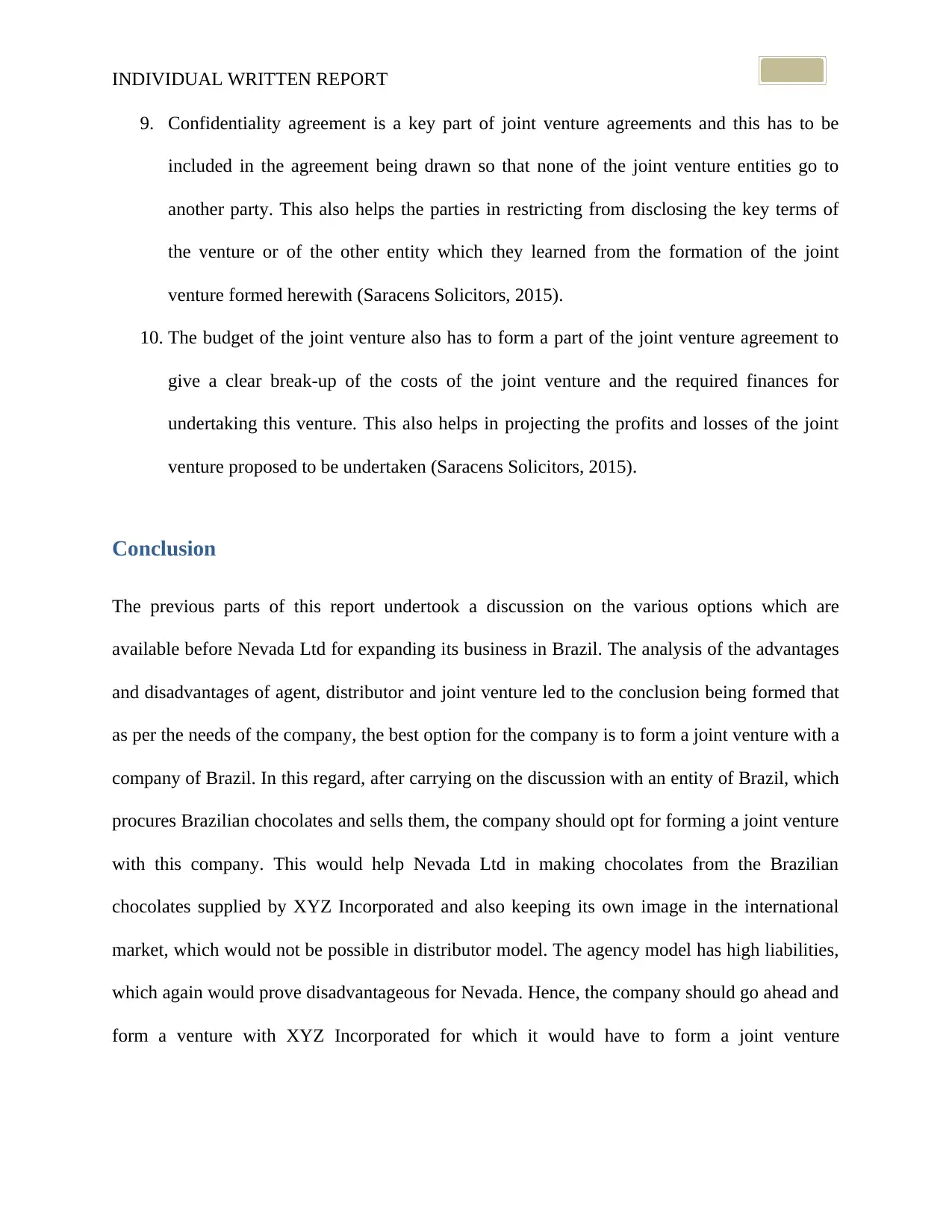
INDIVIDUAL WRITTEN REPORT
9. Confidentiality agreement is a key part of joint venture agreements and this has to be
included in the agreement being drawn so that none of the joint venture entities go to
another party. This also helps the parties in restricting from disclosing the key terms of
the venture or of the other entity which they learned from the formation of the joint
venture formed herewith (Saracens Solicitors, 2015).
10. The budget of the joint venture also has to form a part of the joint venture agreement to
give a clear break-up of the costs of the joint venture and the required finances for
undertaking this venture. This also helps in projecting the profits and losses of the joint
venture proposed to be undertaken (Saracens Solicitors, 2015).
Conclusion
The previous parts of this report undertook a discussion on the various options which are
available before Nevada Ltd for expanding its business in Brazil. The analysis of the advantages
and disadvantages of agent, distributor and joint venture led to the conclusion being formed that
as per the needs of the company, the best option for the company is to form a joint venture with a
company of Brazil. In this regard, after carrying on the discussion with an entity of Brazil, which
procures Brazilian chocolates and sells them, the company should opt for forming a joint venture
with this company. This would help Nevada Ltd in making chocolates from the Brazilian
chocolates supplied by XYZ Incorporated and also keeping its own image in the international
market, which would not be possible in distributor model. The agency model has high liabilities,
which again would prove disadvantageous for Nevada. Hence, the company should go ahead and
form a venture with XYZ Incorporated for which it would have to form a joint venture
9. Confidentiality agreement is a key part of joint venture agreements and this has to be
included in the agreement being drawn so that none of the joint venture entities go to
another party. This also helps the parties in restricting from disclosing the key terms of
the venture or of the other entity which they learned from the formation of the joint
venture formed herewith (Saracens Solicitors, 2015).
10. The budget of the joint venture also has to form a part of the joint venture agreement to
give a clear break-up of the costs of the joint venture and the required finances for
undertaking this venture. This also helps in projecting the profits and losses of the joint
venture proposed to be undertaken (Saracens Solicitors, 2015).
Conclusion
The previous parts of this report undertook a discussion on the various options which are
available before Nevada Ltd for expanding its business in Brazil. The analysis of the advantages
and disadvantages of agent, distributor and joint venture led to the conclusion being formed that
as per the needs of the company, the best option for the company is to form a joint venture with a
company of Brazil. In this regard, after carrying on the discussion with an entity of Brazil, which
procures Brazilian chocolates and sells them, the company should opt for forming a joint venture
with this company. This would help Nevada Ltd in making chocolates from the Brazilian
chocolates supplied by XYZ Incorporated and also keeping its own image in the international
market, which would not be possible in distributor model. The agency model has high liabilities,
which again would prove disadvantageous for Nevada. Hence, the company should go ahead and
form a venture with XYZ Incorporated for which it would have to form a joint venture

INDIVIDUAL WRITTEN REPORT
agreement. And this report aptly highlights the different terms which have to be included in this
agreement based on the needs of Nevada Ltd.
agreement. And this report aptly highlights the different terms which have to be included in this
agreement based on the needs of Nevada Ltd.
⊘ This is a preview!⊘
Do you want full access?
Subscribe today to unlock all pages.

Trusted by 1+ million students worldwide
1 out of 15
Related Documents
Your All-in-One AI-Powered Toolkit for Academic Success.
+13062052269
info@desklib.com
Available 24*7 on WhatsApp / Email
![[object Object]](/_next/static/media/star-bottom.7253800d.svg)
Unlock your academic potential
Copyright © 2020–2025 A2Z Services. All Rights Reserved. Developed and managed by ZUCOL.





